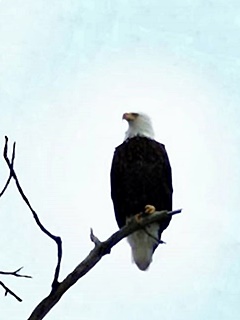
Welcome to Hemlock and Canadice Lakes!
Barns Businesses Cemeteries Churches Clinton & Sullivan Columns Communities Documents Events Time Line Fairs & Festivals Farm & Garden Hiking Homesteads Lake Cottages Lake Scenes Landscapes Library News Articles Old Maps Old Roads & Bridges Organizations People Photo Gallery Podcasts Railroad Reservoir Schools State Forest Veterans Videos
|
“Nature in the Little Finger Lakes” by Angela Cannon Crothers |
|
|
Nesting Time for Eagles By Angela Cannon Crothers March 2015 It’s March. The eagles are nesting. “Onehda Tecarneodi” was the name the early Seneca Peoples called Hemlock Lake in a time when white-headed eagles shadowed their broad wings over its waters. But less than a hundred years after the bird was declared a new nation’s emblem - clutch of arrows in one talon and an olive branch in the other - the soaring eagle’s population was decimated by both a war raged on predator and poaching for elegant feathers. So few majestic eagles remained by 1940, Congress passed the Bald and Golden Eagle Protection Act. Even still 25 years later, less than 420 mating pairs of eagles were counted nesting in all of the lower 48 states. Eagles soared no longer over Hemlock Lake. They were listed on the Endangered Species Act of 1973. One remaining pair of bald eagles was found in New York State, in a half-ton nest atop a towering shagbark hickory on the south end of Hemlock Lake. Dansville resident, outdoor enthusiast, and telephone linesman, Tom Rauber, was amazed and thrilled to discover the pair, but after lengthy observations he noted that their eggs never hatched. The thinning and cracking of eggs for birds of prey had become a frightening norm; the DDT-pesticide-related cause was made notable by biologist and writer, Rachel Carson. In 1976, the nation’s bicentennial year, New York implemented the first Bald Eagle Recovery Program. The nesting eagles on Hemlock Lake became foster parents after Rauber, and DEC biologist, Mike Allen, climbed up and carefully placed hacked chicks in their large nest. The pair of bald eagles atop that shagbark hickory were natural parents and for three years they successfully raised and fledged young. But one early spring, the male disappeared. He was found dead. He’d been shot. Another season came and went. The female bald eagle returned the following March with a new mate. This foster mother, a bird who usually mates for life, continued to raise hacked eaglets for five more years, long after se was laying eggs of her own. Now, every March, over 60 years since we nearly lost the bald eagle in North America, eagles on Hemlock, the marshes of Conesus, Canandaigua, and other area Finger Lakes, roost in enormous aeries - raising young all on their own. There was time when no one believed we could extinguish an entire species by hunting it to the brink of extinction. But we have. There was a time when people did not believe our chemical poisons - our fertilizers and pesticides - could affect other animals, even ourselves. But they do. And now, so many people and politicians still do not consider the impact of human activity on our region’s fresh water or our planet’s global climate as a whole. The eagle, whether brooding in a high nest through early spring snowstorms or flattening its wings against a hot blue sky, is as soaring a reminder as any; a clear symbol of more than a nation or a land, but an indication that we can heal our damage if done soon enough. We can live in peace. The bald eagle teaches us that our ways of being are attached to everything and everyone around us, the whole world through. It’s March. The eagles are nesting. We are better than we thought we could be.
|
||
|
Editor’s Note: Angela Cannon Crothers is a naturalist and writer who teaches at Finger Lakes Community College and with The Finger Lakes Museum. Here are some columns that she has written about the Little Finger Lakes. Her columns also appear in the Lake Country Weekender newspaper.
|
||
